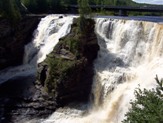I had the idea to blog all of Highway 11 / Yonge Street when I was eight hours into a drive from Timmins to Thunder Bay.
I had been working up in the Timmins area and figured why not use the civic holiday weekend to drive out to Thunder Bay. (I figured I’d never be so “close” by again.) I had just left Geraldton when I saw a young hitchiker walking west in the middle of one of those storms where the rain falls at just the right diagonal angle that you wonder if it’ll take the paint off your house. It was hitting him so hard that it was knocking his baseball cap around on his head.
 “Boy,” I thought. “I bet this guy had wished he’d read up about this stretch of highway.” It’s a good 70 km to Beardmore. And then I lightbulb went off.
“Boy,” I thought. “I bet this guy had wished he’d read up about this stretch of highway.” It’s a good 70 km to Beardmore. And then I lightbulb went off.
After having a bit of a scare of my own – I would have left Iroquois Falls for Timmins via backroads in the winter with next to no gas, only to be dissuaded by a pleading co-worker. “There’ll be a gas station”, I thought! – I’d been blogging about some of the towns in and around Timmins and northern Temiskaming. They’re all around Highway 11. And Highway 11 is Yonge Street. Why not just turn this into a blog on the world’s longest street?
I had arrived in Thunder Bay feeling triumphant, happy to see the city lights as a signal – that I had done it. I felt like I had practically finished the Boston Marathon or something. Except in my car.
The problem with that thought, however, was again my lack of planning. At that time, I had thought that Highway 11 ended in Thunder Bay. I wasn’t even truly aware that the Highway kept going.
But then I kept following Highway 11 further. And further. And then in Kakabeka Falls, I finally figured it out. Highway 11 kept going. All the way to Atikokan. To Fort Frances. To Rainy River. I hadn’t completed it by any means. I was more than 500 km short!
Sometimes called “Niagara of the North” (when Bracebridge isn’t calling their rather middling falls the same thing), the town of Kakabeka Falls is built around the waterfalls from which it derives its name. Thirty kilometres west of Thunder Bay, Kakabeka Falls is one of Ontario’s natural wonders.
The majestic falls are well worth the parking charge (two dollars per hour at the time of my visit), even for a short stop. There are three lookouts, each with educational displays, and there is a one-lane road which links the two sides of the provincial park and provides a fourth vantage point. On the north side of the highway, there is a beach with beautiful dark blue water. For an added twist, you can attend Kakabeka Bible Camp – just be advised that Kakabeka Falls is a bad spot to try walking on water. (Sorry, so bad. Not funny.)
The Metropolitan Moose is a good bet for baked goods and coffee, and if you’re feeling adventurous, you can try to Chinese food available at the curling club just east of town, although I don’t know if it is quality Northern Ontario Chinese Food.
The town has a four to five motels, an LCBO outlet, gas stations, two amethyst shops (the amethyst signs are really getting old, they’re even on people’s front lawns out here.) There are two churches in town, including St. Theresa’s which is pictured here. Wednesday night is bingo night at the Legion. There are about 6000 people in Kakabeka Falls and Rosslyn Village altogether.
Twenty-four kilometres south of town you can find the wonderfully-titled St. Urho’s Golf Club. (Is that really pronounced “yer-ho’s”?)










